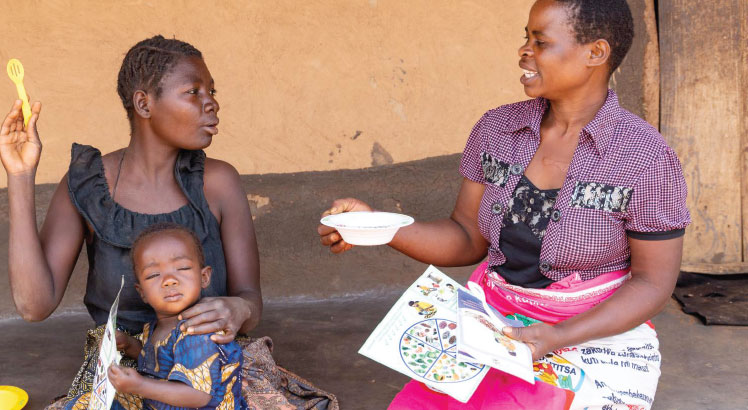A bowl and spoon for every child
To some people, the plastic bowl and spoon that Foniya Eliya uses to feed her 16-month-old baby may appear like fancy utensils, with drawings that attract a child’s attention.
But to Eliya, from Traditional Authority Chimutu in Lilongwe, they are constant reminders of the nutritional needs of her child.
Since she received the bowl and the spoon in August this year, Eliya says feeding her baby, born in May 2021, could never have been easier.
“We were told we should use the bowl for the healthy growth of our child, and it reminds me to give her food that is suitable for her age,” Eliya says.

The bowl has good diversity messages on the rim, and tactile markings for age-appropriate portion sizes inside the bowl to address food quantity.
A handwashing symbol at the bottom of the bowl illustrates the importance of hand hygiene as part of good child feeding practices.
The bowl and spoon she received are part of Unicef’s Complementary Feeding Bowl Project. The objective is to contribute towards improved quality of complementary foods for children under two-years-old.
Additional food
World Relief Malawi nutrition facilitator Mike Magagula says the project is being implemented in Dowa and Lilongwe and targeting under-five children, lactating mothers, and pregnant women.
He explains that training has been done with frontline health workers such as health surveillance assistants (HSAs), promoters and cluster leaders in sanitation and hygiene so that communities can reduce diseases like cholera.
“The other training was complementary feeding. When a child reaches six months, they need additional food. Breast milk is not enough, so you need to add complementary foods that include the six food groups,” he says.
“But the implementation of bowl-and-spoon is the real game changer in promoting nutrition for young children.
“Then there is this bowl and spoon project where we want to improve the complementary feeding because surveys showed that we are not doing well on that,” Magagula says.
Targeted households are provided with a complementary feeding toolkit that comprises a spoon, a bowl, and a counselling card.
Unicef developed the complementary feeding bowl and spoon to give caregivers a simple tool to remember nutrition messages when preparing food for their children.
This will help ensure children receive a diverse and nutrient-dense diet at the right frequency.
Eliya is over the moon with the development.
“I’m still breastfeeding my baby exclusively and have also started providing her with porridge that includes a variety of nutritious foods. I am hopeful that my child will be healthy because of this,” she says.
Chirwa, an HSA under Chimutu Health Centre, considers the bowl and spoon as ideal tools in government’s efforts to deal with undernutrition in children.
“The minimum measurements in the bowl aim to deal with under-nutrition. Whether it’s full, that’s not a problem, the problem is not having enough. Our focus is to prevent undernutrition,” he says.
Bowl and spoon
The spoon focuses on thickness of the food provided to the child.
He says: “The bowl and the spoon help improve child nutrition because they remind the caregiver of the food groups she has to feed the child. “The bowl has boundaries that help the caregiver to measure the amount of food to give the child.
“The right amount of food for a specific age will help the child’s nutrition because the child will take the right quantity for their age. With the bowl and the spoon, you will provide the right quantity and quality to the child.”
As a health worker, Chirwa explains that the bowl and the spoon have simplified counselling about nutrition.
“If all children have been given the right food in the right amounts prepared in the right manner, all of them will be healthy.
“And if a child in every household is healthy, it would reduce the disease burden in the area.”





